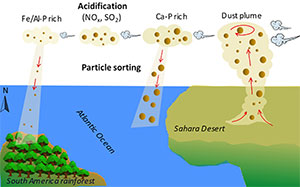UW Researchers Study How Saharan Dust Changes and Supplies Phosphorus to Various Ecosystems
Published September 24, 2021

Saharan dust is an important phosphorus supply to remote and nutrient-depleted parts of the world’s oceans and American lowland tropical rainforests. However, the bioavailability of this phosphorus largely depends on its chemical form.
Mengqiang Zhu, an associate professor in the University of Wyoming Department of Ecosystem Science and Management, and his Ph.D. student studied how the chemical form of phosphorus in aeolian dust -- or windblown silt and clay that get deposited into an ecosystem -- helps determine how effectively dust fertilizes the ecosystem with phosphorus.
“Our goal is to determine the chemical form of phosphorus in the dust source, the Saharan soils, and how the dust-borne phosphorus changes its chemical forms during the long-distance trans-Atlantic dust transport, and by what physical and chemical processes,” Zhu says. “We found that phosphorus composition underwent substantial changes that likely increase the availability of dust-borne phosphorus in marine ecosystems but decrease its availability to America’s rainforests.”
Zhu is the corresponding author of a paper titled “X-Ray Spectroscopic Quantification of Phosphorus Transformation in Saharan Dust During Trans-Atlantic Dust Transport” that was published Sept. 10 in Environmental Science & Technology. The biweekly journal is peer-reviewed and covers research in environmental policy, environmental science and environmental technology.
The lead author of the paper is Than Dam, a Ph.D. student from Hai Phong, Vietnam, who is studying soil science in the UW Department of Ecosystem Science and Management. The research is part of her dissertation.
Other contributors to the paper were from the Hebrew University of Jerusalem in Jerusalem, Israel; the University of Haifa in Haifa, Israel; the University of Leeds in Leeds, United Kingdom; the University of Saskatchewan in Saskatoon, Saskatchewan, Canada; Argonne National Laboratory in Lemont, Ill.; the University of Puerto Rico in Rio Piedras, Puerto Rico; and the University of Aveiro in Aveiro, Portugal.

Phosphorus is a crucial nutrient required by all life forms. Mineral dust is known to be an important source of phosphorus to many nutrient-depleted regions of the world, including open oceans and tropical rainforests.
Annually, 182 million tons of Saharan mineral dust are carried out of Africa. Approximately 28 million tons of that amount are deposited onto the Amazon basin in winter and spring, fertilizing the phosphorus-poor tropical soils. The remaining amount of dust is deposited along its transport pathway, providing an important source of nutrients to the oligotrophic open ocean gyres -- large systems of circular ocean currents formed by global wind patterns and forces created by the Earth’s rotation -- and the Caribbean Sea.
Cape Verde and Puerto Rico were the two study sites chosen because of their locations along the transport route from Africa to America’s rainforests, which also is in the dust transport pathway. Cape Verde, an island in the Atlantic Ocean, is located about 570 kilometers from the west coast of Africa. Puerto Rico represents an American rainforest site and is located about 4,000 kilometers away from the west coast of Africa.
“Our results show that both atmospheric acidification and particle sorting cause the changes of phosphorus chemical composition in Saharan dust,” Zhu says. “This chemical composition changes from phosphate that is dominated by apatite to phosphate that is dominantly bound to iron and aluminum oxides during trans-Atlantic dust transport.”
Apatite is a calcium phosphate compound and the primary phosphorus-bearing mineral in the dust source. It also is the mineral that makes up our bones. Acidification is the reaction between dust particles and acidic air pollutants, including nitrogen oxides and sulfur dioxide, Zhu says.

The acidification dissolves apatite and produces reactive iron and aluminum oxides that absorb the phosphate released from the apatite dissolution, Zhu says. Particle sorting refers to the earlier settlement of dust particles of larger size. So, as the dust plume moves, dust particles that remained in the plume become increasingly smaller. As the smaller dust particles are poor in apatite but rich in iron and aluminum-bound phosphorus, particle sorting also results in increased proportions of aluminum and iron-bound phosphorus.
“Saharan dust inputs have been an important phosphorus nutrient supply to sustain America’s rainforests, which are a major carbon sink and sequester a vast amount of carbon,” Zhu explains. “The tropical rainforest soils are acidic and low in phosphorus, strongly limiting the forest’s primary productivity.
“When the dust arrives in Puerto Rico, it becomes rich in phosphorus that is bound to iron and aluminum, a form of phosphorus having a low availability to plants in acidic soils,” he continues. “Thus, only a portion of dust-borne phosphorus deposited into rainforests is effective in fertilizing the rainforest. This finding allows ecologists to estimate the importance of dust inputs more accurately on fertilizing America’s rainforests.”
On the other hand, iron- and aluminum-bound phosphorus is more soluble and, thus, available in marine environments as seawater is alkaline and favors the dissolution of the phosphorus, Zhu says. After a long-distance transport, dust-borne phosphorus becomes more effective in fertilizing phosphorus-limited oceans, such as the Caribbean. This information would be useful for marine chemists who study phosphorus limitation in nutrient-depleted oceans.
“Our results will inform atmospheric chemists that not only atmospheric acidification -- but also particle sorting -- can change the chemical forms of phosphorus, and probably other elements as well, in aeolian dust,” Zhu says. “The particle sorting pathway had been overlooked in literature.”

